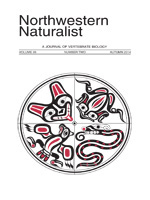Age estimation in wildlife is crucial for population assessment and management decision-making. Estimation errors may reduce the efficacy of management programs or potentially result in poor management decisions. Our objective was to compare aging techniques (gum-line measurement and cementum annuli analysis) for Cougars (Puma concolor) using harvest data collected during 2006–2010 in Oregon. Differences in paired age estimates (cementum annuli estimate minus gum-line recession estimate) had 95% confidence limits of −0.28 and −0.06. Linear regression showed a relatively high level of agreement (<1.0-y difference) between the 2 aging techniques considered for individuals ≥1-y and ≤17-y old. The slope suggests that each 1 y increase in estimated age using cementum annuli analysis adds 1.03 y to the predicted estimated age using gum-line measurements. Disparity between estimates increases with age. Individuals estimated to be 1-y old using x (cementum annuli counts) are predicted to be 1.09-y old using y (gum-line measurements), and individuals estimated to be 12-y old using x are predicted to be 12.42-y old using y. The use of >1 age-estimation technique, implementation of standardized protocols (if not currently in place), and additional training to potentially increase consistency and reduce bias among observers will be beneficial for Cougar management.
How to translate text using browser tools
29 July 2014
Comparison of Two Age-Estimation Techniques for Cougars
Tim L Hiller
ACCESS THE FULL ARTICLE

Northwestern Naturalist
Vol. 95 • No. 2
Autumn 2014
Vol. 95 • No. 2
Autumn 2014
cementum annuli
cougar
gum-line recession
mammal aging
Mountain Lion
Oregon
Puma concolor




